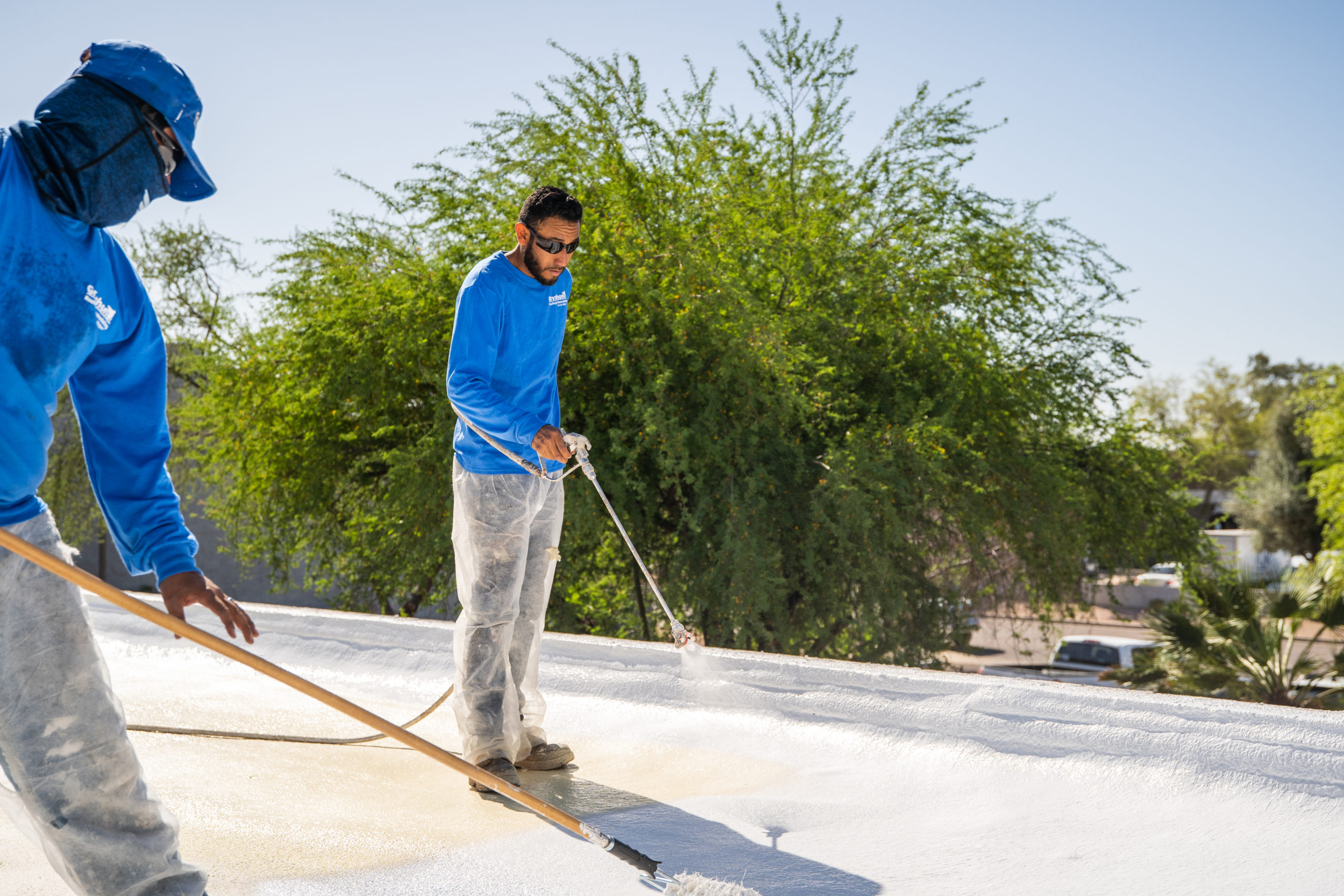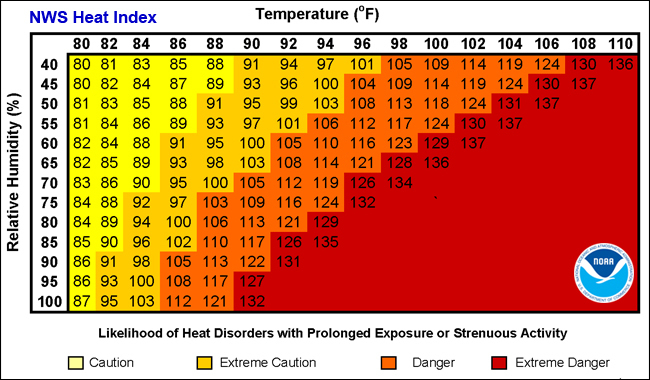Hot Weather Means Increased Safety Precautions for Roofing

It’s May, and above-average temperatures have already hit the Midwest and the eastern United States. With summer looming, and the mercury rising, it’s a good chance to review and consider how the heat and humidity affect your crew, your product, and the safety of all those involved. Roofing demand tends to increase in warmer months, particularly in northern states. Increased demand and longer daylight hours in sweltering temps can be a recipe for disaster, though. The conditions present new dangers and the need for renewed efforts on safety. May is a great time to reiterate safety measures with your team, and to ensure your crews have all they need to stay cool this summer!
UNDERSTAND THE CONDITIONS
Understanding the weather conditions and how it affects your crews is truly the first safety measure you can take. Weather conditions include more than simply the temps outside. OSHA and NIOSH have an excellent heat safety tool app for android and iPhone that gives you not only the ambient temps/forecast but Heat Index, wind, UV, and more. Further, the app can advise on appropriate OSHA-required precautions for your crews based on the conditions.
There are four factors that contribute to heat stress on workers:
• Ambient Air Temperature
• Humidity
• Radiant heat (from sunlight, surfaces, or equipment. Roof coatings would be included here)
• Air Movement (Wind)
Ambient Temp
In general, the closer the ambient temperature gets to body temperature, the more difficult it is for the human body to cool itself. High ambient temperatures rarely come without other factors (like humidity or radiant heat, for example). Keep in mind, that the air temperature is the measure of air temperature in the shade at rest.
Humidity
Humidity factors in here as well! When the humidity index is high (meaning more moisture in the air), sweat evaporates more slowly off your skin and clothing. Sweat (and the evaporation of sweat into the air) is how the body cools itself. Slower evaporation means less efficient cooling of the body.
Conversely, low humidity with high heat can be just as problematic! In this situation, sweat evaporates rapidly. While this may be helpful for cooling off the skin, it often leads to high levels of dehydration, as crews don’t realize how much they’re sweating, and drink less fluids.
Radiant Heat
Temperature readings do not account for the heat generated by fire, on-site equipment or materials, or heat-absorbing surfaces like roads or roof surfaces. Perhaps most often overlooked is the increased radiant heat of the sun itself. Weather services measure temperature and heat index in the shade. Workers in full sunlight will experience considerably hotter temps. Direct sunlight increases temperatures by an average of 13.5° F.
Workers applying roof coatings may be especially susceptible to risks in this category, as their rigs include heating systems, and workers’ personal protective equipment can add quite a bit of heat to the situation
Air Movement
In most situations, air movement is a good thing in the heat. However, be aware of how your job site is affected by wind. Rooftops can experience heat-sinking effects, as well as wind blocks from the variation in building design or nearby buildings. If your crew is applying Spray Polyurethane Foam (SPF) roofing or similar material, your crew may be seeking days with as little wind as possible to reduce overspray. While this is helpful for reducing overspray, it can increase temps. Consider bringing on additional workers to follow or precede the sprayer with a windscreen.
MAXIMUM HEAT INDEX FOR ROOFING
In addition to OSHA-NIOSH’s app, the National Weather Service provides this chart for a quick reference of the heat index. As we’ve shown above, the heat index is not a complete measure of heat safety but can serve to be a helpful guide.
Heat Index is a measure of ambient air temperature + relative humidity, but keep in mind, that the readings on this chart are taken in the shade. Direct sunlight will increase the index significantly. If working in direct sunlight (as most roofing jobs are), add 10-15° to your temperature when reading this chart. It’s worth noting, in normal humidity conditions (~30% RH), NIOSH recommends rescheduling any roofing jobs if the temperature is at or above 106°. That’s a maximum. Increases in direct sunlight, worker health, RH % or total heat index will drive that maximum down. Considerable caution should be given to any temps 93° or higher, given the guidelines for direct sunlight work. Even more so for spray-applied roof systems like Rugged Coatings. PPE (personal protective equipment) will drive the maximum temp further down without proper precautions.

TIMING IS EVERYTHING
You may be reading this thinking, “If my company canceled work every time the temperature got up in the 90s, we’d never get any work done!” It’s true; roofers and contractors like yourself are well-accustomed to working in harsh conditions. And, if you’ve been in the business long, you know that timing is everything.
Utilize early hours to get a jump on the rising temperatures. Starting in the early light hours can often allow a crew to complete their shift before the hottest part of the day even arrives. If you’re applying spray-applied roof coatings, earlier hours in the day tend to have lower amounts of wind as well. Beyond planning your shift times, be diligent about planning water breaks. Consider having your crew leads document breaks with a chart on the side of the water cooler — it’s that important!
And, contrary to popular belief in the industry, taking a break inside air-conditioned buildings or vehicles will not take away your body’s acclimation to working in the heat. In fact, most workers acclimate to working in the heat and sun within 7-10 days. This is a very real and documented acclimatization, where workers’ bodies will sweat and pump blood more efficiently in these conditions. Taking breaks in air-conditioning will not lengthen the time it takes a worker to build up this ability, nor will it take away existing acclimation. Pushing harder in the heat will hurt, not help workers’ heat tolerance. Take breaks, cool off, rehydrate, and stay safe.
Use these guidelines from NIOSH on Heat Acclimatization with your new workers. Deaths or hospitalization from heat stress most often occur within the first few days on a job.
KNOW YOUR CREW, KNOW THE SIGNS
Dehydration and other heat-related illnesses are no joking matter. Dehydration makes the heart pump harder as the body has a lower blood volume. Dehydration causes struggles with sweat and temperature control issues, which creates a downward spiral of symptoms.
There are key signs of heat-related issues, however: headaches, changes in mood, lack of urination, fatigue, dizziness, or confusion. For instance, if a worker becomes forgetful, seems “out of it” or seems less focused, you should assume they’re experiencing heat-related symptoms!
A common myth in the industry is that once your body is acclimated to working in high temps, it will sweat less. The opposite is true. The body becomes more efficient at using its resources to keep you cool, which means acclimated workers will often sweat more than new workers and lose more fluid. Acclimated workers must hydrate themselves proactively.
How Much Should Roofers Drink in Hot Weather?
Roofing laborers can lose 6 to 8 liters of water a day in sweat alone. That’s 211-281 fluid ounces. Workers should be drinking 8 ounces of fluids every 15-20 minutes to keep up.
Heat-related symptoms increase the risk of other job site safety issues, such as fall risks. Fall protection and ladder safety should be top priorities in high heat months.
Other Heat-Related Illnesses (and their symptoms):
Heat Exhaustion
Occurs when the body is struggling to regulate its temperature. The body temperature will rise, and the individual may struggle to remain functional. Heart rate increases and the worker may experience headache, nausea, vertigo, thirst, weakness, heavy sweating, or irritability. Seek medical care immediately, remove unnecessary clothing, bring the worker to a cool location, and rehydrate steadily.
Heat Syncope
Heat Syncope is a fainting spell caused by heat as the body struggles to effectively keep proper blood pressure. The worker may feel dizzy or lightheaded, or may even fall over/faint, even if they had just been standing. Heat Syncope often occurs when a worker goes to get up after taking a short break. Lie down in a cool area, drink fluids, and allow your blood pressure to recover.
Heat Stroke
Heat Stroke is a high emergency, and the signs are not as clear as once thought. Many roofers have heard over the years “the first sign of heatstroke is that you stop sweating”. This is not necessarily true, and workers can experience heatstroke while still sweating. Symptoms include high body temp, odd behavior and confusion, hot skin, loss of consciousness, or seizures.
If you suspect heatstroke, call 911 immediately. Move the person to a cool location, and work to cool their body as quickly as possible. Ice baths, cold wet cloths, removal of clothing — anything you can do to help bring down the body’s temperature.
Conclusion
Warm weather brings full schedules and a busy season for many contractors. Don’t let your busy season get slowed down by a preventable tragedy. Keep your crews safe this summer, recap safety procedures, and update your heat and weather-related policies!


